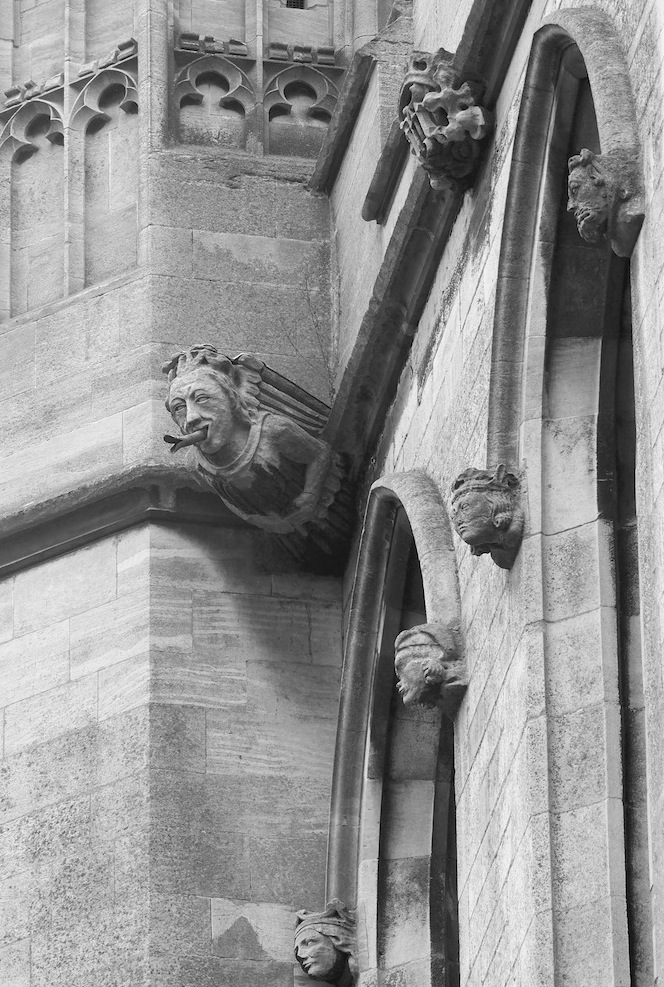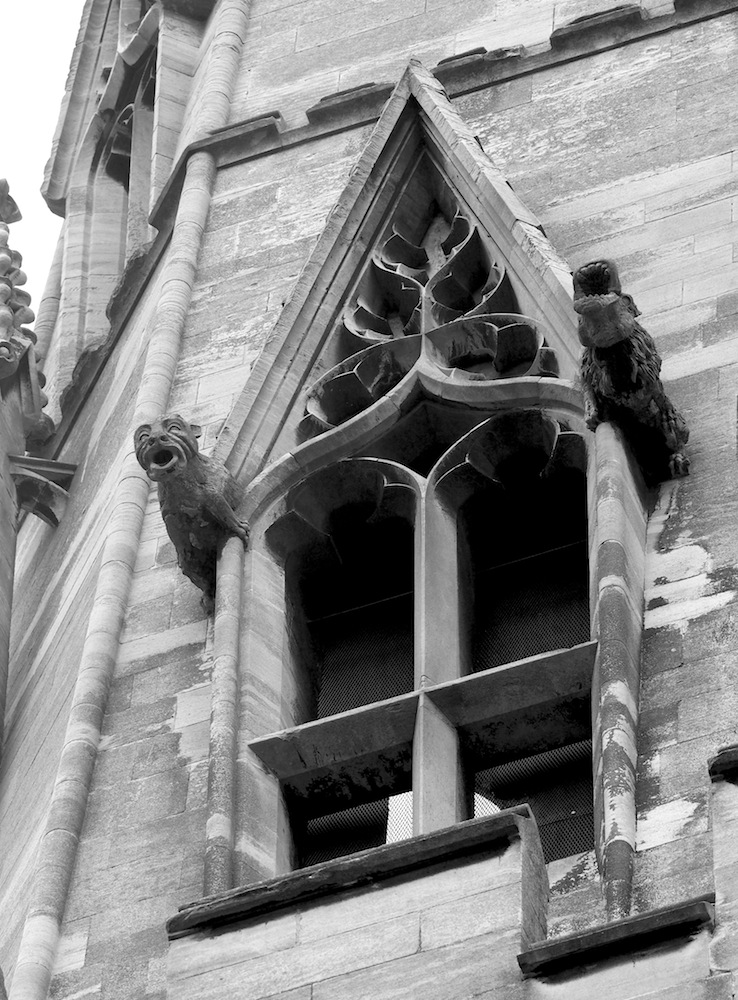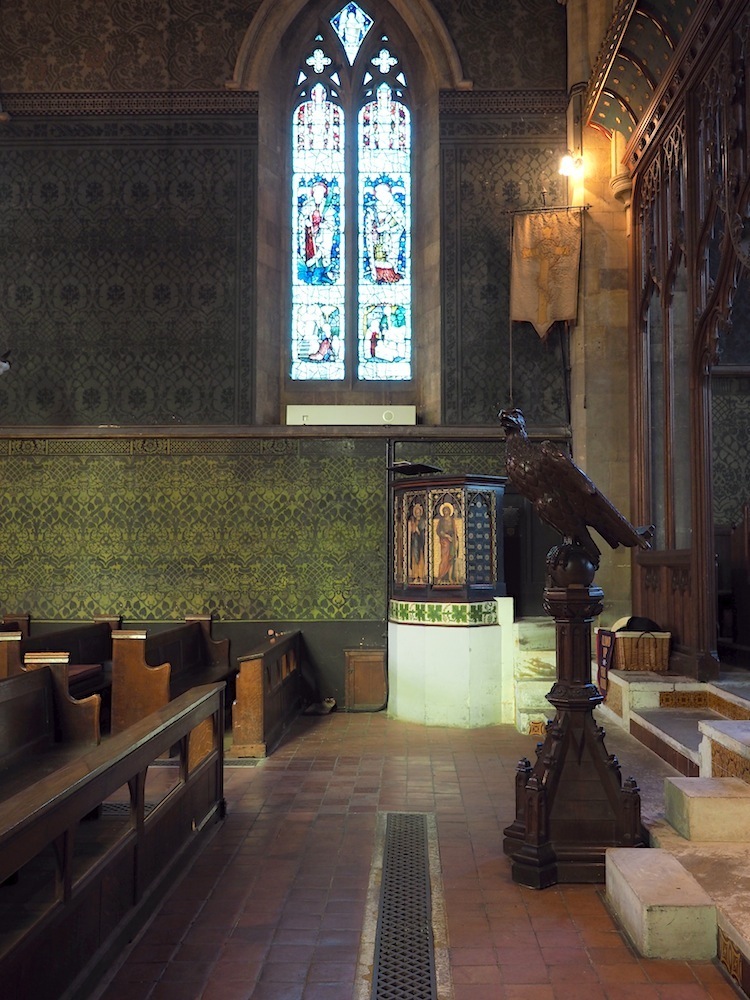All photographs except the first on the right were generously contributed by Adrian Powter, Churches Conservation Trust area volunteer, whose copyright they remain. The one of the church exterior from the east is by Andrew Dunn from Wikimedia, kindly made available on this Creative Commons licence. [Click on all the images to enlarge them.]


All Saints, looking towards the east end (left) and west end (right).
All Saints, Jesus Lane, Cambridge, was designed by George Frederick Bodley (1827-1907). The main part of church was built in 1863-4; the spire and north wall tracery came later, in 1869-70. Materials: "Handmade brick faced with ashlar, tiled roofs. Interior arcade of Ancaster stone" (listing text). Originally built as the parish church, to replace the smaller, inconveniently projecting church which stood opposite St John's College, this was a brilliant example of Bodley's work. After changing his initial plan for a "muscular" church more like St Michael's, Brighton, he settled on the English Decorated style of the fourteenth century, his first use of such a style. With its tall ribbed broach spire rising from the tower over the chancel, it provides a fine landmark for the town.
The plan is straightforward: a nave and chancel, south aisle, a tiled vestry to the south east, an organ chamber and a door at the north-west, making a gabled entry from Jesus Lane. It was Grade I listed in 1950, partly because it represented a notable and decisive step in Bodley's career, partly for its contribution to the townscape, and also (very importantly) for its rich interior decorative scheme, devised by Bodley himself, William Morris, and others. Simon Jenkins was irked to find the church in a "deplorable state" at the end of the twentieth century (53), but restoration of the interior was completed a few years later under the auspices of the Churches Conservation Trust, which had been responsible for the church since 1981. Perhaps it was a blessing that the process started late, when the church's historic and aesthetic value was more fully appreciated: according to the listing text, it has remained "one of the best preserved Anglo-Catholic interiors in England."





Showing up better in black and white are an array of external details, including brickwork, tracery, hood-moulds and label-stops, gargoyles and the crocketed pinnacle of the stair-turret giving access to the tower.
According to Nikolaus Pevsner, the tracery and all these details are from the turn of the thirteenth to the early fourteenth century (221). The gargoyles at the top of the battlemented tower are particularly splendid, but all the carving here is first class. It is worth noting that in designing the church in this style Bodley was supported by two Ecclesiologists from Jesus College, which had given the land for the church in 1860: John Corrie, who was the Master then, and a fellow, John Gibson (see Searby 41).
Interior



Left to right: (a) The nave, looking towards the east window from the north-west side, near the door. (b) The south aisle, with its impressive arcade. (c) Looking into the north-west corner of the nave, at the lectern (1900) and pulpit (designed by Bodley, 1864).
On a dull day, the church can seem rather dark inside, even with the lighting on. But the arcade gives an impression of space, and the two arches beyond — the large chancel arch and the smaller one across the south aisle, hint at a crossing (as the listing text suggests). More striking, however, is the rich stencilled and painted decoration throughout, from walls to roof, and even in the vestry. The predominant colours are green, gold and red.

View from the choir to the west end, with the north-west door on the far right.
The designs for the painted decoration, first by Morris working with Bodley, and then by Bodley himself, were executed by the locally based studio of Frederick Leach (1837-1904), and by Wyndham Hope Hughes (l849-l948), an artist associated with Charles Eamer Kempe and working under his supervision. Morris was involved here for the first phase of the stained glass too, most notably contributing the magnificent east window, with many of its figures designed by Edward Burne-Jones. Kempe was later responsible for three windows in the north aisle. There are also windows in the south aisle by the well-known firm of Ward and Hughes, and another celebrated window in the north aisle from much later on, 1944, by Douglas Strachan (1875-1950).



Left to right: (a) and (b) Two views of the nave roof. (c) The tower roof or choir canopy.
The nave and south aisle both have tie-beam and king-post roofs, while the tower roof, over the choir, is necessarily flat but panelled, and the sanctuary has a wagon roof. All are works of art in themselves, the canopy at the east of the nave decorated by William Morris & Co., and the nave and south aisle roofs by Leach.
Related Material
- All Saints' Memorial Cross, Cambridge, by Basil Champneys (erected in memory of the older All Saints, demolished in 1865)
- All Saints Church, Cambridge: II, Fixtures and Fittings
- All Saints Church, Cambridge: III, Stencilled Decorations
- All Saints Church, Cambridge: IV, Christ in Majesty, painted by W. H. Hughes
- All Saints Church, Cambridge: V, Jesus Blessing the Children, painted by W. H. Hughes
- East Window by Morris and Company (also a series)
- West window angels by Morris and Company
- Three windows by Charles Eamer Kempe / Kempe & Co. (see his index)
- Windows by Ward and Hughes (see the firm's index)
- Womanhood window by Douglas Strachan
- Godwin tiling in the sanctuary
Bibliography
"All Saints Church." Historic England. Web. 1 April 2018.
"All Saints Church, Cambridge, Cambridgeshire." Churches Conservation Trust. Web. 1 April 2018.
Garrett, Martin. Cambridge: A Cultural and Literary History. Oxford: Signal Books, 2004.
Jenkins, Simon. England's Thousand Best Churches. Rev. ed. London: Penguin, 2009.
Pevsner, Nikolaus. Cambridgeshire. London: Penguin, 1970.
Searby, Peter. A History of the University of Cambridge, Vol. III: 1750-1870. Cambridge: Cambridge University Press, 1997.
Stavridi, Margaret. "Wyndham Hope Hughes l849-l948." Wheat Sheaf Newsletter of the Kempe Society. No. 49 (March l996): 5-8.
Tricker, Roy, and others. All Saints Church. London: Churches Conservation Trust, 2004 (kindly supplied by Adrian Powter).
Last modified 8 April 2018